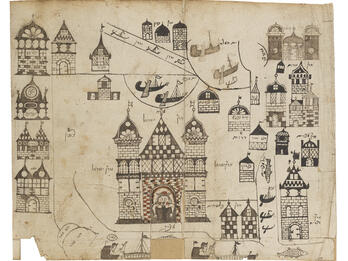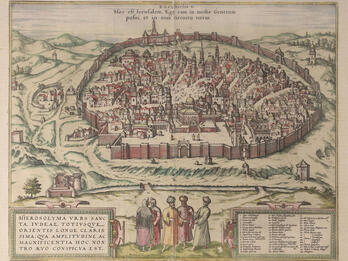Seder ha-dorot (Order of the Generations)
You O reader, my friend and the dear one of my desire, you should know that great is the benefit of knowing the generations, as shall soon be demonstrated. [ . . . ] Therefore I have arranged before you the Order of the Generations. Part I is from the First Man [Adam] until the beginning of the Tannaim [rabbis of the Mishnah], including all the Tannaim and the Amoraim [rabbis of the Talmud] and the Saboraim [the rabbis who redacted the Talmud], and the Geonim, and the authors of legal decisions, one generation after another. Part II presents the order of the Tannaim and the Amoraim, with information on who are the master and the disciple, or colleague and contemporary.
If you are like the wise son, you will ask, “Are you not cooking an old stew?” and “Who are you to do this? You have been preceded by a very awesome man, the author of The Guide [of the Perplexed], in his splendid book, the man known as Maimonides, who did so in his introduction to the Mishnah.” However, I have seen that the rabbi and speaker [Vidal of Tolosa] in many places wrote words about him that are as hard as a sinew—far be it from me to express my opinion, based on my mind and knowledge, and decide, after bowing and kneeling—only sometimes I will show an explicit proof from the sea of the Talmud. And you, reader, may choose for yourself what pleases your palate.
Now against the author of Shalshelet ha-kabalah I raised an embankment, to separate the choice flour from the waste, for virtually all of it is full of errors. [ . . . ] I have tried to correct the errors, for your benefit, as you will see in this composition of mine. Also, the author of Tsemaḥ David, although he walked along the straight path regarding the order of generations mentioned in the Bible, however, when it came to the order of the Tannaim and Amoraim he took a shortcut, mentioning one per generation. The wise author of genealogies, Ḥosen yeshu‘ot, did a marvelous job in putting together a list of the sages of the Mishnah and the Amoraim of the Talmud. See, wise one, with your intellect, and peer through the cracks [see Song of Songs 2:9]; give to the wise and he will become wiser (Proverbs 9:9), for their ways are not mine (Isaiah 55:8).
Praise be to God tenfold, I will laud and give thanks, as a small candle like me is better for seeking in holes and cracks than a great light and a torch [see b. Pesaḥim 4a]. They left a place for me because the rabbi who composed the genealogies omitted many of the Tannaim and did not memorialize them, [ . . . ] and truly with regard to the Amoraim we are in agreement, like a priest who collected a miserly contribution, he took one part in sixty from the Babylonian Talmud, which he lists in his compendium, and indeed from the Jerusalem Talmud he took a negligible amount, diluted in 960 parts. Meanwhile, those sages mentioned in the Mekhilta, Sifra, Sifre, Tosefta, [Midrash] Tanḥuma, [Midrash] Rabba, Midrash Shoḥer Tov [Midrash Tehillim], the Zohar and Midrash ha-ne’elam, and Pirke de Rabbi Eliezer, and Midrash Konen—blessed be the One who gives knowledge—he did not place any of these on his lip, not even the amount of earth that a fox brings up from a plowed field [see, e.g., b. Yoma 43b].
Therefore, see, wise reader, that all my words are drawn from the great sea of the Babylonian and Jerusalem Talmud, and I based them on the sapphire of Sifra and Sifre, and with the beauty of the Mekhilta I anointed them, and with the gleam of [Midrash] Rabba and [Midrash] Tanḥuma I polished them, and from the tiles of the Geonim and the authors of the Tosafot I set them in place. [ . . . ] I arranged them [the Tannaim and Amoraim] according to the alphabet, so that it follows the order of the [grammatical] root. My table will be set, he who acknowledges it is blessed; I did so to reduce the reader’s difficulty, in a time of need [ . . . ] and I arranged them as much as possible in their order of birth and in their correct generations.
Furthermore, I acted as one who gathers seeds from the books of the kabbalists, to determine regarding each of the Tannaim and Amoraim of whom they are a reincarnation, and likewise regarding the first generations, from the First Man onward, and the prophets and kings—so you can understand and comprehend the wonders of the Lord—they are all explained in accordance with the reincarnation that repaired the souls of the earlier ones, or corresponding to those whose earlier deeds they upheld.
The Many Benefits of Knowing the Generations: Who Was the Teacher and Who the Disciple
This is the straight path trod by the ancients, R. Alfasi and the great teacher Maimonides, and those who came after them, as they sought to understand and instruct, when they called out the generations [see Isaiah 41:4] from the sea of the Talmud. [ . . . ] The end of the matter, all having been heard (Ecclesiastes 12:13) is that in a place where it is not explicitly stated that the law is in accordance with So-and-So, as opposed to the disputing opinion of So-and-So, it can be assumed that the law does not follow a disciple against his master, or a later authority against an earlier one. [ . . . ] I performed a kindness for you by quoting from Alfasi and the authors of the Tosafot and the Rosh, in every case where the halakhah is ruled in accordance with one Sage rather than the dissenting view. And in those cases where these authorities do not expressly state whom the halakhah follows, you may judge and conclude by yourself, once you know the generations, who is the teacher and who is the disciple.
Translated by
.
Credits
Yeḥiel Heilperin, “Seder ha-dorot (Order of the Generations)” (manuscript, Minsk, ca. 1697). First published as: Jehiel ben Solomon Heilprin, Seder ha-dorot (Karlsruhe, 1769). Republished as: Jehiel ben Solomon Heilperin, Seder ha-dorot, ed. Naftali ben Avraham Maskil le-Etan, vol. 1 of 3 (Warsaw: Bi-defus Y. Goldman, 1882; repr., Bet ha-sefer), pp. 1–2 (?).
Published in: The Posen Library of Jewish Culture and Civilization, vol. 5.




